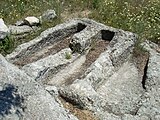Tumba Olèrdolana
Tumbas Olèrdolana (oder Tumbas antropomórficas) ist der seit dem 19. Jahrhundert übliche Name für zumeist vergesellschaftete, mittelalterliche, in den Fels von Aufschlüssen[1] gehauene Gräber. Aufgrund der großen Anzahl dieser Strukturen in Olèrdola (bei Barcelona) erhielten sie in Spanien den Namen Tumbas Olèrdolana, den Alberto del Castillo, einer der Väter der spanischen Mittelalterarchäologie, populär machte.
Beschreibung
Die auch Tumbas rupestres oder Tumbas visigoticas genannten Gräber haben anthropomorphe Form und sind über die Iberische Halbinsel hinaus z. B. in Frankreich (Beaucaire) und England (Felsgräber von Heysham) verbreitet. Trotz diversen Zweifeln an der Chronologie ist heute klar, dass die meisten in der Spätantike und im Mittelalter verwendet wurden.
Siehe auch
Literatur
- Jordi Vital: Alberto del Castillo y la arqueología medieval 2016
Weblinks
Einzelnachweise
- ↑ Es gibt in Valderredible (in Kantabrien) auch Tumba exenta genannte, aus dem Fels gehauene anthropomorphe Sarkophage.
Auf dieser Seite verwendete Medien
Autor/Urheber: BigSus, Lizenz: CC BY 2.5
Tumbas antropomórficas u olerdolanas de Santa María de La Piscina (La Rioja, España).
Autor/Urheber: Borjaanimal, Lizenz: CC BY-SA 3.0 es
Monasterio de Sant Quirze de Colera - Tumba Antropomórfica
Autor/Urheber: Valdavia, Lizenz: CC BY-SA 3.0
Anthropomorphic or "Olerdola" tombs at the necropolis of the rock carved chapel of San Vicente en Vado, Cervera de Pisuerga (Palencia, Castile and León). It is located close to the confluence of river Rivera with the Pisuerga, and it falls within one of the large Spanish hermitage groups, the one of Alto Pisuerga. It basically presents a large rectangular room with several entrances and rough openings, to which is added a chapel excavated in the East, differentiated from the rest by a step that may have been closed using a masonry apse. The chapel is surrounded by a necropolis, dated between the 8th and 11th centuries, where about twenty tombs excavated in the rock have been discovered, predominantly of anthropomorphic type. The chapel and the necropolis probably formed part of a small monastic complex that would possess other buildings today disappeared, as well as cells excavated in the rock (lauras) that still remain. After the monastic community disappeared, San Vicente retained its role as a chapel until the middle of the 19th century, when it was permanently abandoned.
An anthropomorphic tomb in Villaverde, Carrascosa del Campo, in the municipality of Campos del Paraíso, Province of Cuenca, Spain.
Autor/Urheber: GFreihalter, Lizenz: CC BY-SA 3.0
Anthropomorphe Gräber an der Kapelle Santa María de La Piscina in Peciña in der spanischen autonomen Gemeinschaft La Rioja
Autor/Urheber: Cruccone, Lizenz: CC BY 3.0
Visigoth tombs near Colmenar Viejo, Madrid
Autor/Urheber: GFreihalter, Lizenz: CC BY-SA 3.0
Höhlenkloster Saint-Roman bei Beaucaire, einer Gemeinde im Département Gard in der französischen Region Languedoc-Roussillon, in den Felsen geschlagene Gräber













